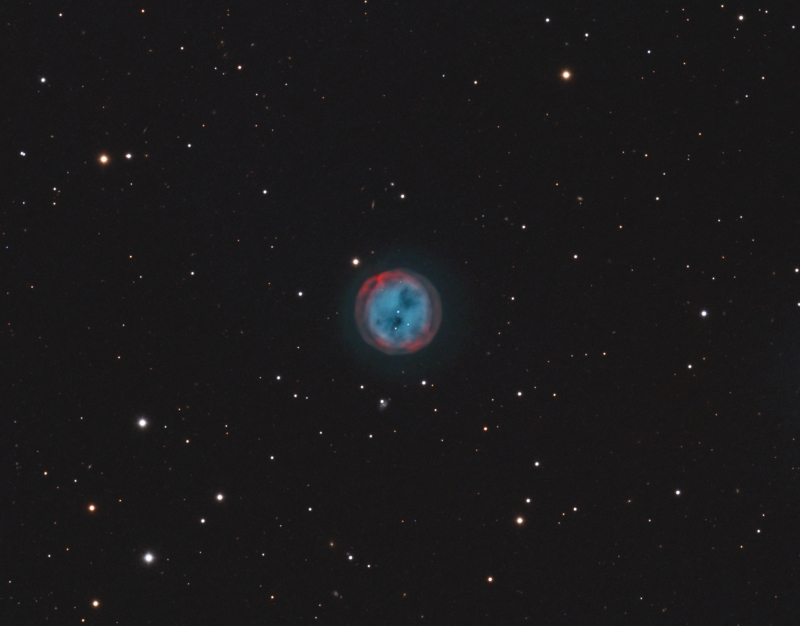M97 (NGC 3587) The Owl Nebula
Published 7 April 2020

Larger size jpg images available here: 1920pix Full size: Full resolution uncropped image
About this object: Courtesy of Wikipedia
The Owl Nebula (also known as Messier 97, M97 or NGC 3587) is a planetary nebula located approximately 2,030 light years away in the constellation Ursa Major.[2] It was discovered by French astronomer Pierre Méchain on February 16, 1781.[5] When William Parsons, 3rd Earl of Rosse, observed the nebula in 1848, his hand-drawn illustration resembled an owl's head. It has been known as the Owl Nebula ever since.[6]
The nebula is approximately 8,000 years old.[7] It is approximately circular in cross-section with a little visible internal structure. It was formed from the outflow of material from the stellar wind of the central star as it evolved along the asymptotic giant branch.[4] The nebula is arranged in three concentric shells, with the outermost shell being about 20–30% larger than the inner shell.[8] The owl-like appearance of the nebula is the result of an inner shell that is not circularly symmetric, but instead forms a barrel-like structure aligned at an angle of 45° to the line of sight.[4]
The nebula holds about 0.13 solar masses of matter, including hydrogen, helium, nitrogen, oxygen, and sulfur;[4] all with a density of less than 100 particles per cubic centimeter.[8] Its outer radius is around 0.91 ly (0.28 pc) and it is expanding with velocities in the range of 27–39 km/s into the surrounding interstellar medium.[4]
The 14th magnitude central star has since reached the turning point of its evolution where it condenses to form a white dwarf.[5][8] It has 55–60% of the Sun's mass, 41–148 times the brightness of the Sun,[4] and an effective temperature of 123,000 K.[9] The star has been successfully resolved by the Spitzer Space Telescope as a point source that does not show the infrared excess characteristic of a circumstellar disk.
The Owl Nebula (also known as Messier 97, M97 or NGC 3587) is a planetary nebula located approximately 2,030 light years away in the constellation Ursa Major.[2] It was discovered by French astronomer Pierre Méchain on February 16, 1781.[5] When William Parsons, 3rd Earl of Rosse, observed the nebula in 1848, his hand-drawn illustration resembled an owl's head. It has been known as the Owl Nebula ever since.[6]
The nebula is approximately 8,000 years old.[7] It is approximately circular in cross-section with a little visible internal structure. It was formed from the outflow of material from the stellar wind of the central star as it evolved along the asymptotic giant branch.[4] The nebula is arranged in three concentric shells, with the outermost shell being about 20–30% larger than the inner shell.[8] The owl-like appearance of the nebula is the result of an inner shell that is not circularly symmetric, but instead forms a barrel-like structure aligned at an angle of 45° to the line of sight.[4]
The nebula holds about 0.13 solar masses of matter, including hydrogen, helium, nitrogen, oxygen, and sulfur;[4] all with a density of less than 100 particles per cubic centimeter.[8] Its outer radius is around 0.91 ly (0.28 pc) and it is expanding with velocities in the range of 27–39 km/s into the surrounding interstellar medium.[4]
The 14th magnitude central star has since reached the turning point of its evolution where it condenses to form a white dwarf.[5][8] It has 55–60% of the Sun's mass, 41–148 times the brightness of the Sun,[4] and an effective temperature of 123,000 K.[9] The star has been successfully resolved by the Spitzer Space Telescope as a point source that does not show the infrared excess characteristic of a circumstellar disk.
Image Details
- Optics : Stellarvue SVX 152 refractor @f8 1216 mm FL
- Mount: Paramount MYT
- Camera: QSI 683
- Filters: Astrodon
- Exposure (min): LRGBHaOIII: 300:300:310:310:400:1000 min Total 43.6hrs
- Camera/Mount Control: The Sky X, CCD Auto Pilot 5
- Guiding: StarlightXpress Lodestar X2
- Processing: PixInsight
- Location: Stark Bayou Observatory, Ocean Springs, MS
- Sky: Typical SQM 19.6-20.0, Bortle 5, Suburban
- Date: 31Dec 19-28Feb 2020






